For emergencies, staying on trail, updating family and friends, and checking the weather forecast, satellite messengers are invaluable pieces of gear.
Depending on which you choose satellite messengers can, as their name implies, simply send messages while others offer useful added features.
With some devices you can send and receive messages (two-way messengers) while others only send (one-way messengers). Some have GPS functionality, others pair with your phone, and still others do everything in a single handheld device.
Not sure which is the best satellite messenger for you?
In the article below we take an in-depth look at the best satellite messengers for backpacking and hiking.
As always, check our deal finder before buying to scan 40+ outdoor gear sites for possible deals.
Best Satellite Messengers
Satellite messengers come in a variety of shapes and sizes. Below are our top picks plus a few runners up with details on device specifications, pricing, subscriptions, and activation fees.
• Best All-Around Satellite Messenger: Garmin inReach Mini 2
• Best Paired Satellite Messenger: Somewear Global Hotspot
• Best Budget Satellite Messenger: ACR Bivy Stick
• Best Satellite Messenger With a Keyboard: SPOT X
• Best Personal Locator Beacon: ResQLink View, SPOT Gen4
Best All-Around Satellite Messenger
Garmin inReach Mini 2
The gold standard for all things satellite, the Garmin inReach Mini 2 is an ultralight, rugged, and extremely capable backcountry messenger. This is an ideal choice for frequent users involved in multiple outdoor activities. Pricing plans can be a bit more costly than other devices but the inReach Mini 2 offers, by far, the most functionalities and versatility of any satellite messenger.
Weight: 3.5 oz/100 g
Battery: Rechargeable lithium-ion
Battery Life: Up to 30 days @ 30 min. track interval, up to 1 year powered off
Messaging: Two-way
Size: 2.04″ x 3.9″ x 1.03″
Pairs With: Smartphone
Weather Forecast: Yes (detailed/marine weather is an add-on)
SOS Function/Tracking: Yes
Location Sharing: Yes
Full Keyboard: No
Pros & Cons:
• Compact & lightweight
• Impact resistant & IPX7 waterproof
• Texting can be cumbersome
• Simplistic GPS navigation
• Flexible 3-tiered pricing plans
• TrackBack routing
Also available from: Amazon

Garmin inReach Mini 2 Details
With improvements to the user interface, connectivity, and slight design tweaks, the Mini 2 is a welcome improvement on the original inReach Mini. Both models support all the functionalities of a satellite messenger. Other than more detailed GPS navigation, there is literally nothing the inReach Mini 2 can’t do that other backcountry satellite devices can.
The inReach Mini 2 allows for SOS with interval tracking, message received confirmation, texting while paired with a smart phone or through the inReach device itself.
You can also share your location between Garmin devices and there is preset messaging and location sharing.
And, with TrackBack routing, you can easily retrace your steps if you do get lost.
It’s rated IPX7 waterproof. Meaning, it can be submerged in up to 1 meter of water for up to 30 minutes without damage.
The original inReach Mini is still available from some retailers. The Mini runs about $50 cheaper than the upgraded Mini 2 and is still one of the best satellite messengers available.
All Garmin devices work on the Iridium Satellite Network (one of the fastest and most reliable). You can expect fairly quick up-link times depending on your location and view of the sky.
For first time satellite network users, it is not uncommon to wait anywhere from 1 minute to 10 minutes to get a good satellite connection while in the backcountry. On average, Garmin products take less than 5 minutes for a successful connection.
If you like the inReach Mini 2 but want a full built-in keyboard, take a look at the Garmin GPSMap 66i or Spot X.
Garmin inReach Mini 2 Subscriptions and Fees
Garmin subscriptions are among the most costly of all satellite messengers. They do however offer 3-tiered pricing options as well as their “Freedom” plan.
Freedom Plan
• Annual fee of $34.95
• Pay monthly
• Suspend service anytime with no charge
• Maintain access to Garmin Portal data during account service suspension
The Basic, Recreation, and Expedition plans are annual plans that all require a $29.95 activation fee and are billed monthly.
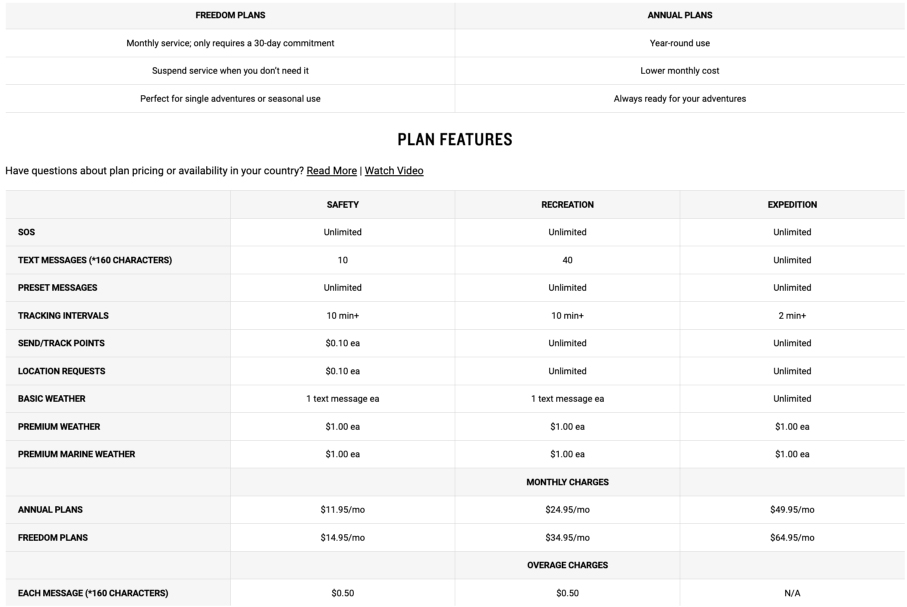
Best Paired Satellite Messenger
Somewear Global Hotspot
The Somewear Global Hotspot is a striped down alternative to the Garmin inReach Mini 2 that offers similar functionalities (when paired with a smartphone) alongside more affordable pricing plans. Keep in mind, pairing with a smartphone is required to use this satellite messenger. While the Global Hotspot itself has a robust battery life (see below), consider your phone’s charging needs when planning a trip with the Somewear Global Hotspot.
Weight: 4 oz/113 g
Battery: Rechargeable lithium-ion
Battery Life: Up to 1000+ messages per charge, up to 10 days @ 10 min. track interval, 4-5 months powered off
Messaging: Two-way
Size: 3″ x 3.6″ x 0.8″ (no built in display)
Pairs With: Smartphone (required for use)
Weather Forecast: Yes (detailed/marine weather is add-on)
SOS Function/Tracking: Yes
Location Sharing: Yes
Full Keyboard: N/A
Pros & Cons:
• Works on wifi/data
• Compact & lightweight
• Impact resistant & IP68 waterproof
• Requires smart phone for use
• No preset messages
• Affordable pricing plans

Somewear Global Hotspot Details
While relatively new on the scene, the Global Hotspot from Somewear Labs has quickly become a crowd favorite.
The fact that it lacks any built in display means this satellite messenger must be paired with a smartphone for use. The Somewear app offers a sleek and easy to use interface with a number of valuable features like SOS, location sharing and tracking, and full two-way messaging.
Still, the required pairing is a limitation to consider. Somewear’s messenger is great for shorter trips or occasions where carrying extra charging devices for your phone is not an issue.
The Global Hotspot is also the perfect travel companion since it works seamlessly over wifi and cellular data networks.
For global travel or backpacking where keeping your cell phone charged is not an issue, the Somewear Global Hotspot is smart satellite messenger with an affordable price tag.
Somewear Global Hotspot Subscriptions and Fees
Somewear Labs gives their customers an affordable subscription pricing structure with the added flexibility of their Ultralight plan.
Ultralight Plan
• Perfect for occasional check-ins and/or emergency use
• $8.33/month
• Annual contract required
• SOS
• Weather reports
• Both satellite and wifi messages
Somewear’s other pricing plans are billed monthly and offer more robust text messaging packages including satellite track points.
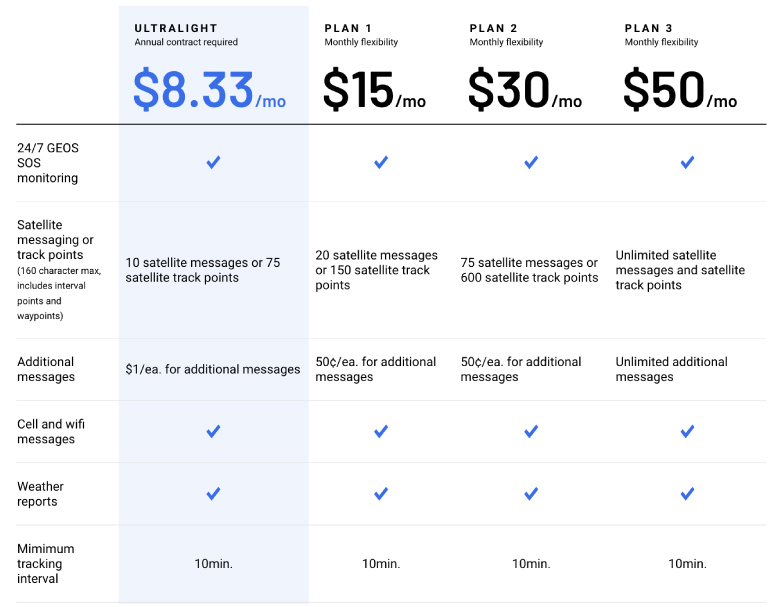
Best Budget Satellite Messenger
ACR Bivy Stick
With a low price point, no activation fees, and a no commitment month-to-month subscription plan, the ACR Bivy Stick gives you the most affordable satellite messenger without compromising on features. The Bivy Stick offers one touch SOS, confirmation of SOS receipt, location sharing and tracking, two-way messaging through their smartphone app integration, and weather forecasts (basically everything the inReach Mini offers at a fraction of the price).
Weight: 3.35 oz/95 g
Battery: Rechargeable lithium-ion
Battery Life: Up to 120 hours in default operation settings
Messaging: Two-way
Size: 4.4″ x 1.85″ x 0.83″
Pairs With: Smartphone App
Weather Forecast: Yes (detailed/marine weather is add-on)
SOS Function/Tracking: Yes
Location Sharing: Yes
Full Keyboard: No
Pros & Cons:
• Dedicated phone number
• Durable clip on design
• Impact resistant & IPX7 waterproof
• One-touch SOS & location share
• Use on multiple phones
• Most affordable pricing plan
Also available from: Amazon

ACR Bivy Stick Details
Best known for their Personal Locator Beacons (PLBs), ACR makes a reliable product capable of transitioning from sea to summit without breaking your bank or your ultra-light weight limit.
Check out ACR’s Survivor Stories for some inspiring cautionary tales.
The Bivy Stick offers the same features as the Garmin inReach Mini 2 but with one big difference: there is no integrated screen.
This means you can’t use any of the Bivy Stick’s advanced functions like two-way messaging without a paired smartphone with the ACR app installed. You will need to plan accordingly to keep your phone charged through out your trip.
That said, you can use the Bivy Stick on multiple phones (one phone at a time) as long as each phone has the app installed. And, even without a phone you can send SOS messages as well as enable tracking and sharing.
A single LED on the back of the Bivy Stick changes color and/or blinking patterns to help confirm message receipt, tracking, and GPS signal strength.

Overall, Bivy Stick is a great satellite messenger for any adventure. If you don’t want to worry about keeping both your smartphone and your messenger device charged, it might not be the best option for you.
However, an affordable and flexible pricing plan paired with a rugged and easy to use design make the ACR Bivy Stick a smart option for budget conscious adventurers whose trips don’t usually last more than a few days a few times a year.
ACR Bivy Stick Subscriptions and Fees
ACR is one of the only satellite communicator manufacturers to offer commitment free subscription plans with zero activation fees.
The only catch; you must commit to four months upfront. After that initial 4 months, you can cancel or change plans at any time.
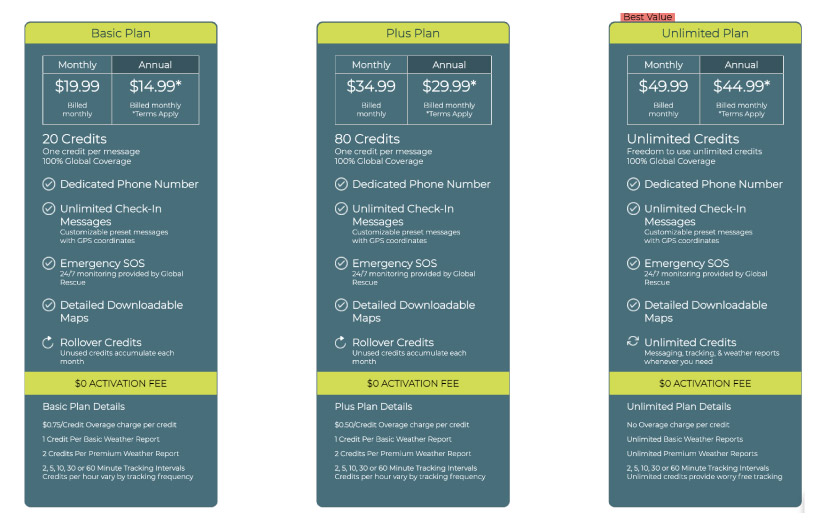
Best Satellite Messenger With a Keyboard
SPOT X
The SPOT X is the only satellite messenger to provide a full physical (rather than screen based) keyboard. However, the device can still pair with a smartphone and the keyboard feels a little generic. SPOT devices run on the Globalstar network, a satellite provider with less reach than the Iridium network. The SPOT X allows for custom two way messaging with or without a paired phone, SOS with tracking, vehicle rescue, and a built in compass.
Weight: 7 oz/198 g
Battery: Rechargeable lithium-polymer
Battery Life: Up to 240 hours
Messaging: Two-way
Size: 6.5″ x 2.9″ x 0.94″
Pairs With: Smartphone
Weather Forecast: No
SOS Function/Tracking: Yes
Location Sharing: Yes
Full Keyboard: Yes
Pros & Cons:
• IPX7 Waterproof
• Full QWERTY keyboard
• Vehicle rescue add-on
• Paired phone not required for two-way messaging
Also available from: Amazon

SPOT X Details
The defining feature of the SPOT X satellite messenger is its full QWERTY keyboard.
Having a full keyboard allows you to send and receive two-way messages directly to your device without the need for a paired smartphone.
While this is possible on the Garmin inReach Mini 2, typing out messages on the SPOT X is much faster.
Still, the SPOT X is approximately twice the weight of the inReach and lacks the ruggedness of design compared to the inReach.
Keep in mind that the SPOT X works on the Globalstar satellite network rather than Iridium. This may not be an issue for travel in and around North America and most of Europe. On average, Iridium does offer better performance, especially in the hardest to reach global destinations.
SPOT X offers an intuitive though clunky user interface with similar features to the inReach with a slightly more affordable pricing plan, albeit on a sub-premium satellite network.
SPOT X Subscriptions and Fees
All SPOT X plans require a yearly commitment as well as a $29.95 activation fee.
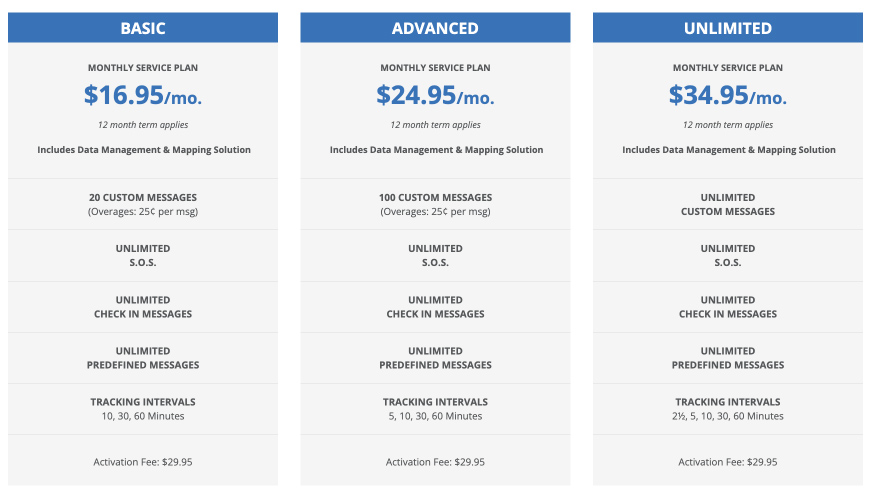
Best Personal Locator Beacon
ResQLink View
When it comes to PLBs, the ResQLink View is truly the best of the best. Lightweight, buoyant, and ruggedly built with a digital display screen that provides live status, SOS confirmation, and GPS coordinates; the ResQLink View PLB is an indispensable travel companion no matter where the trail takes you. The ResQLink also features built-in strobe lights for night rescue, and a multi-constellation receiver for more accurate and reliable positioning.
Weight: 5.2 oz/148 g
Battery: Non-hazmat lithium
Battery Life: Up to 28 hours operational
Messaging: No
Size: 4.5″ x 2″ x 1.5″
Pairs With: N/A
Weather Forecast: No
SOS Function/Tracking: Yes
Location Sharing: Yes
Full Keyboard: No
Pros & Cons:
• Digital display
• Multi-constellation receiver
• MEOSAR compatible
• Waterproof: 1 hour @16.40 ft, 10 min. @ 33 ft
• Easy to use
• Floats
• No subscription or activation fees
• LED & infrared strobe lights for night rescue
• Multifunction clip & ACR skins included
Also available from: Amazon

ResQLink View Details
When you want peace of mind without all the bells and whistles, PLBs are a functional alternative to full satellite messengers.
Designed for survival, the ResQLink View is reliable and simple to use. By simply deploying your antenna and pushing a button your SOS with GPS coordinates are sent to the nearest rescue authorities.
A built in digital display provides SOS confirmation, updated GPS coordinates, and live beacon status. Integrated LED and infrared strobe lights assist in low visibility or night time rescues.
The ResQLink is also self-buoyant, waterproof up to 10 meters, and uses a multi-constellation receiver for greater global connectivity and improved location accuracy.
ResQLink View Subscriptions and Fees
No subscription or activation fees are required for the the ResQLink View.
SPOT Gen4
In the SPOT Gen4 you get an easy to use PLB with shared tracking, custom check in messages and the ability to send non-emergency-need-for-assistance messages with GPS coordinates to your contacts.
Weight: 5 oz/142 g
Battery: 4 x AAA batteries
Battery Life: Up to 1,250 check-ins/messages
Messaging: One-way
Size: 3.48″ x 2.66″ x 0.93″
Pairs With: N/A
Weather Forecast: No
SOS Function/Tracking: Yes
Location Sharing: Yes
Full Keyboard: No
Pros & Cons:
• Customizable messages
• Non-urgent SOS
• Only IP68 waterproof
• Location sharing & tracking
• Smart on/off to save battery life
• Easy to replace AAA batteries
Also available from: Amazon

What is a Satellite Messenger?
A satellite messenger is a device (paired with a cell phone or standalone) that uses satellites rather than land based towers to send and receive messages and data.
These devices are generally small, relatively lightweight, and durable.
Some, like the Garmin inReach Mini, can pair with your cell phone or work as a standalone device. This allows you to send and receives text messages on your phone anywhere in the world.
You can, without a cell phone, text directly from the InReach but the process can be a bit cumbersome or time consuming.
Here’s Clever Training explaining how to send both preset and custom text messages (@ 2:35 minutes) using the inReach Mini as a standalone device.
You may also hear the term, “satellite communicator.” Most of the time the two terms are used interchangeably (in this article we use both terms to mean the same thing).
Some only send preset messages and/or send coordinates while other devices can send and receive messages, track your progress on GPS, and send coordinates, or receive weather forecasts.
All satellite messengers and communicators are capable of sending some sort of emergency GPS coordinate or message (see product details above for the particular functionalities of each device).
What Can Satellite Messengers Do?
Many satellite messengers can do more than just send a message.
Depending on which device you choose there are a number of added functionalities that can be extremely useful in the backcountry or abroad.
• Messaging
• SOS
• Location Sharing & Tracking
• Weather Reports
Messaging
First, how does messaging work?
All satellite communicators use a satellite network to relay their messages. Each brand will use a specific satellite network and some sort of fee will be required as pay-per-use or a subscription.
As of writing, the Iridium Network (Garmin devices work on the Iridium Network) is the largest satellite network available to the public.
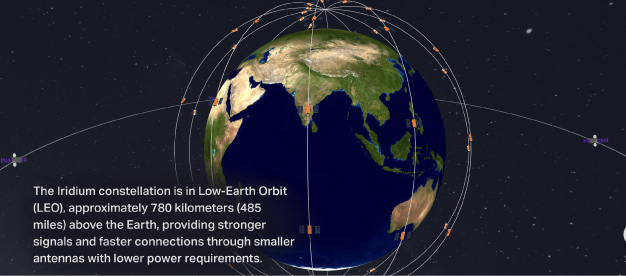
Once you have a subscription setup, your device works similar to a cell phone.
However, while cell phone reception depends on your location and proximity to cell towers; satellite messengers only need a clear view of the sky to get signal and send and receive messages.
Today’s more powerful satellite communicators can even get signal through cloud cover or overhead trees, but this will take up more battery power with usage.
Depending on which device you choose, messages can go one-way or two-way.
One-way means you can send messages to people but you cannot receive their replies.
Two-way means you can both send and receive messages.
Subscriptions and Satellite Messenger Pricing
Outside of the cost of the actual device, it is important to be aware of associated activation and usage fees that come with all satellite messengers.
Unlike PLB’s that use public networks for emergency services, satellite messengers use private networks and require a subscription.
This is similar to most cell phones. You can make an emergency call without purchasing a phone plan but to make standard text messages or phone calls you will need to sign up for a plan of some kind.
Satellite messenger’s use either a pay-as-you-go, or monthly and yearly contracts. And, just like cell plans you will usually pay less for a yearly contract over monthly subscriptions and should also anticipate some sort of activation fee.
For example, Garmin plans range from $11.95/month to $49.95/month while annual plans run between $3-15 less per moth compared to monthly plans.
They have a $29.95 activation fee and if you prefer a monthly subscription over yearly contracts you will need to pay an additional $34.95 annually.
While Garmin devices require a subscription as well as an activation fee, there are more affordable options for users who don’t plan on using their device as often or do not need all the functionalities of a full service Garmin messenger.
Both Bivy Stick and SatPaq offer more flexible pricing.
Bivy Stick requires an initial 4 month commitment with no activation fee. After the first 4 months you can cancel anytime.
SatPaq has a pay-as-you-go model. You buy credits for a certain amount of messages and you can top up online anytime.
In general, however, higher subscription fees do translate to better network functionality between devices.
For pricing and subscriptions details by device see our detailed product reviews above.
SOS
When it comes to backcountry travel, safety is always a big concern.
Satellite messengers give you the ability to quickly send SOS messages and coordinates in case of emergency no matter your location.
Almost all devices do this with a single button push. In most cases a preset message with GPS details about your location will be sent to an emergency response service.
Here’s how to send an SOS with the Bivy Stick using both the app and the device alone.
Most devices also allow for set tracking intervals – once an SOS is sent your device will continually track your GPS location and relay the updated coordinates to emergency services.
Some devices allow you respond or “chat” with the emergency service, others simply send your message and coordinates.
Read product details before purchase to ensure the satellite messenger you choose has the functionalities you want. Above, we give SOS details for the best satellite messengers.
Location Sharing & Tracking
Another useful feature offered by advanced satellite messengers like the InReach and Somewear Labs Global Hotspot is location sharing and tracking.
According to Somewear Labs, their Global Hotspot allows you to share your real-time location with up to 10 people. Activating this feature is simple, requiring only a few pushes of a button.
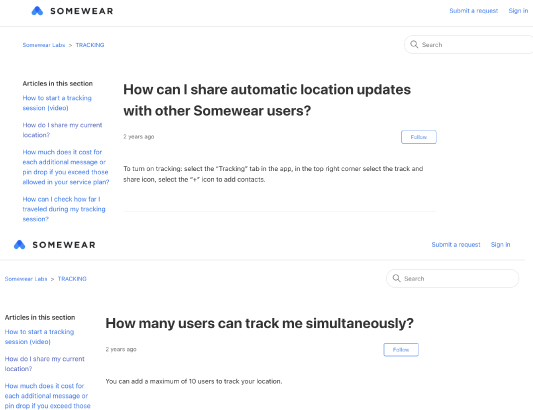
Use this feature for safety or for group travel.
Share your route with friends and family back home. They will be able to share the journey with you in real-time to make sure you are safe and on track.
When you send an SOS your device will continually track your location and allow responders to see your coordinates in real-time.
Weather Reports
Both the Somewear Labs and Garmin allow you to request weather forecasts through the device interface.
On Garmin devices you access weather through the satellite messenger itself.
With Somewear Labs use the integrated mobile app to view weather forecasts.
How Satellite Messengers Work
Most of us know more or less how a cell phone works: a network of single towers with information sending and receiving capabilities are linked into a larger network.
When we send a text message to someone far away, that message is relayed from one tower to the next until it reaches the receiving cell phones’ service are.
Satellite messengers work exactly the same, only they use satellites for their communication network. Your device is then linked to the satellite network and all messages and information are sent through the satellites.
Because satellites orbit the earth in space, your linked device’s reception or ability to send and receive is capable of working anywhere on earth (as long as you have a relatively unobstructed line of sight to the sky).
What is a PLB?
PLB stands for Person Locator Beacon. These simple devices are generally reserved for emergency use only.
With the push of a button, a PLB will send an SOS with your personal information and location to the nearest authority capable of search and rescue.
Keep in mind, PLB’s lack the full functionality of satellite messengers.
While you can still send an SOS and your location, with many device you cannot send or receive custom messages and there is no way to confirm your message has been received by the authorities or to track the progress of the search and rescue party.
Still, PLBs work (check out ACR’s survivor stories for a bit of PLB inspiration) and if you don’t need or don’t want all the functionalities of a satellite messenger, there are some benefits to a PLB over a messenger.
PLB’s can be more affordable, the battery life is often much longer than satellite messengers, you don’t have to worry about keeping two devices charged (in the case of messengers that pair with your cell phone) and most don’t require costly subscriptions.
For example, one of the most popular PLB’s on the market, the ACR Electronics ResQLink 400 has a 5-year battery life with 24+ hours of operational battery life, requires no subscription, and works anywhere in the world.
Keep in mind, as of 2009 all PLBs working on 121.5 and 243 MHz frequencies have been phased out. Emergency satellites no longer monitor these frequencies for distress signals. If you own an older PLB, upgrade to a 406 MHz beacon asap.
Do Satellite Messengers Require a Subscription?
Unlike PLB’s, satellite messengers do require a subscription.
Some devices like the ACR Bivy Stick offer pay-per-credit or pay-as-you-go plans while Garmin devices require a subscription as well as an activation fee.
See our explanation above for more details.
What is The Best Satellite Messenger Network?
Today, almost all satellite messengers work off the Iridium Satellite Network.
SPOT and Higher Ground devices use the Globalstar and Intelsat satellite networks respectively.
Iridium is the largest commercial satellite network (there are other private and government satellite networks) in the world with claimed coverage to 100% of the planet.
In addition, Iridium uses satellites in Low Earth Orbit (LEO), which they assert allows their network to offer faster communication speeds and better functionality in adverse weather conditions.
How to Choose a Satellite Messenger
Finding the best satellite messenger for you depends on a few important considerations:
• Standalone vs. Paired Messengers
• One-Way or Two-Way Satellite Messengers
• Screen Size & Type
• Subscriptions & Fees
• Waterproofness
• Battery Life
Mainly, do you want a standalone device, one you pair with your smartphone, or one that can do both?
Do you need one-way or two-way messaging, how often will you use your device, how long are your backcountry trips, and how much added weight are you willing to put up with?
Below, we take a more detailed look at each of these considerations.
Standalone vs. Paired Messengers
Satellite messengers like the SPOT Gen4 are standalone satellite messengers. Meaning, they don’t need to be paired with a smartphone or app to work as intended.
Some standalone devices like the SPOT X have an integrated keyboard, but as of writing these keyboards are a bit clunky and also make the device much more bulky than its counterparts.
Standalone messengers without keyboards, like the Garmin inReach Mini use a series of preset messages, scrolling letters, as well as predictive messaging and writing accessed by toggling within the message screen.
For anyone around when cell phones first became a thing, this is similar to text messaging where you had to hit a button three times to get the letter “L,” it’s a bit more cumbersome but once you’re used to it writing messages is quick and easy.
A standalone device does have its benefits over paired devices.
One, you don’t have to worry about keeping two devices charged. Satellite messengers have much better battery life than your standard cell phone, so once fully charged they should last the duration of most backpacking trips.
Two, messengers are also much more durable and water resistant than cell phones. If your satellite messenger requires a cell phone to work properly and that phone is lost or damaged your messenger’s functionalities become extremely limited.
And three, you save on weight and packing space.
One-Way or Two-Way Messaging
Regardless of their other functionalities, satellite messengers come in two types: one-way messengers or two-way.
As the names imply, one-way messengers can only send messages one way.
That is, your device can send messages to your contacts or and SOS to search and rescue but you will not be able to receive replies or updates.
Two-way messengers allow you to both send and receive messages, updates, and information.
One-way messenger’s limited functionality makes them more of a PLB than a true satellite messenger.
Screen Size & Type
If you plan on having detailed text conversations over your satellite messenger you might be better off with a paired device or one with an integrated keyboard.
As mentioned above, two-way standalone devices do have custom texting capabilities, but the screens are compact and it can take some time to compose a long message.
You can get around this without losing all the advantages of a two-way device by getting a messenger capable of being paired with a cell phone but that does not need pairing for full functionality.
The Garmin inReach Mini is a great example of this. With the Mini you can use the toggle buttons to choose pre-made messages or compose custom ones, or you can pair it with your smartphone, allowing you to send and receive messages as usual.
Subscriptions & Fees
As far as costs go, satellite messengers are reasonably priced compared to other highly technical electronic devices.
What can add up, however, are the required subscription fees.
Remember, these devices work off of a satellite network and similar to cell phones, a subscription or payment plan of some kind is required to access that network.
You can see full subscription and pricing details in the product boxes above.
Waterproofness
All the satellite messengers listed in this article are rated water-resistant/waterproof.
Some like the ACR ResQLink View are waterproof and float.
Keep in mind, even if the satellite messenger itself is waterproof, your cell phone might not be. In this case, when using a paired device, plan accordingly and have a backup PLB in case of emergency.
Battery Life
Satellite messengers have much better battery life than cell phones or digital cameras.
If you are using a messenger that pairs with your phone, be sure to have an extra power bar or solar charger for your phone.
Summary
Satellite messengers are handheld devices that allow you to stay in touch, access emergency services, and navigate safely while in remote areas anywhere in the world.
Satellite messengers can be one-way or two-way.
One-way messengers only send messages to your contacts or to emergency services but you will not be able to get replies or in some cases know if your SOS has been received.
Two-way messengers work like a cell phone. Text messages can be both sent and received.
Most handheld devices lack a full keyboard so messaging is limited to preset messages or toggling to find words and letters.
Paired satellite messengers solve this problem by pairing with your smartphone.
In this case, you send and receive text messages in your cell phone the same as usual but messages are relayed through a satellite network rather than a cell network.
Some messengers like the Garmin inReach Mini and Explorer+ can work with or without a cell phone while others like the Somewear Labs Global Hotspot must be paired with a phone to access full functionality.
In general, satellite messengers have a much longer battery life compared to cell phones.
When opting for a paired messenger remember that you will need to consider charging needs for both devices while in the backcountry.
If you simply want a communicator for emergencies, consider a Personal Locator Beacon or PLB.
It is worthwhile to have a simple PLB as a backup if your lose or damage your paired cell phone or satellite messenger.
PLB’s are simple devices that when activated, send an SOS with GPS coordinates to emergency services while tracking your location.
These devices come with a lower price point but much less versatility than messengers.
Accessing remote and rugged areas is what backcountry travel is all about. But, sometimes things don’t go exactly according to plan.
With a quality satellite messenger you’ll be able to check in with contacts and be more prepared for whatever the adventure might throw at you no matter where you are in the world.




